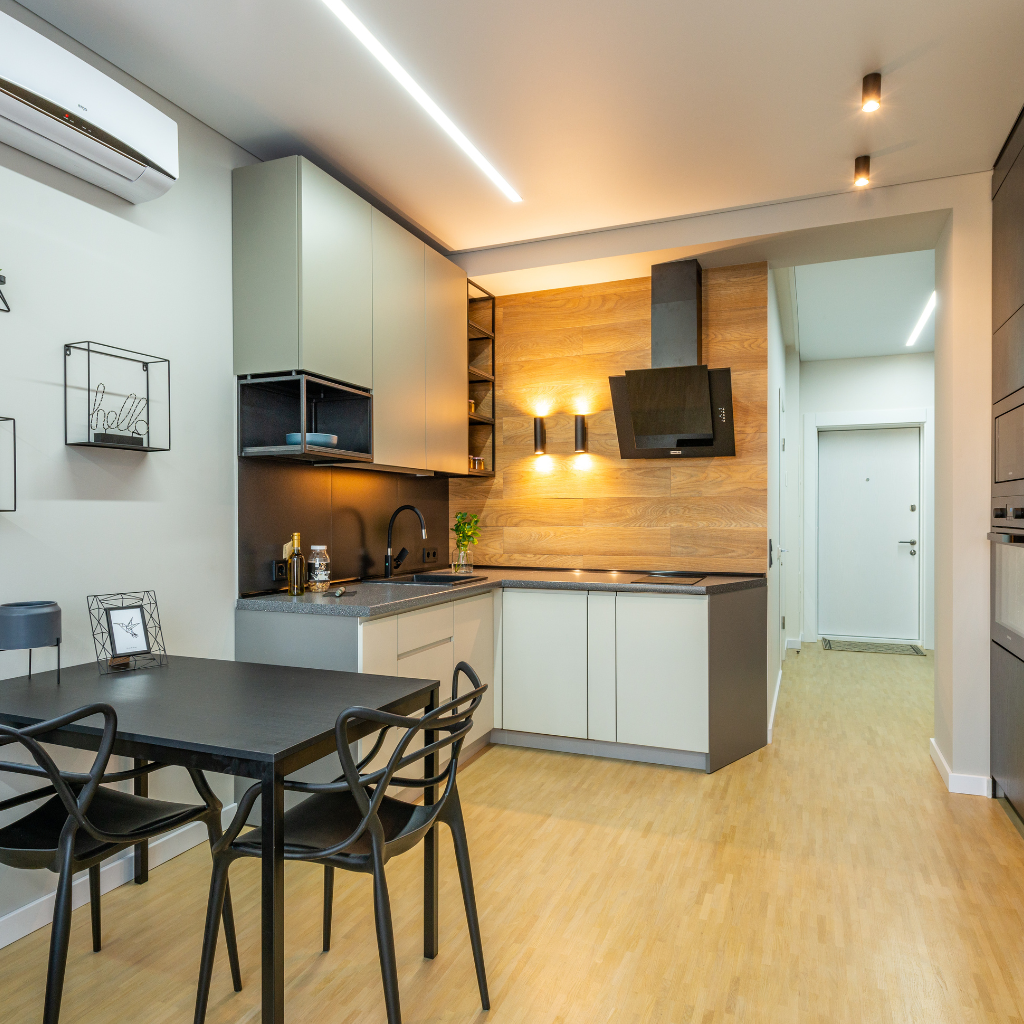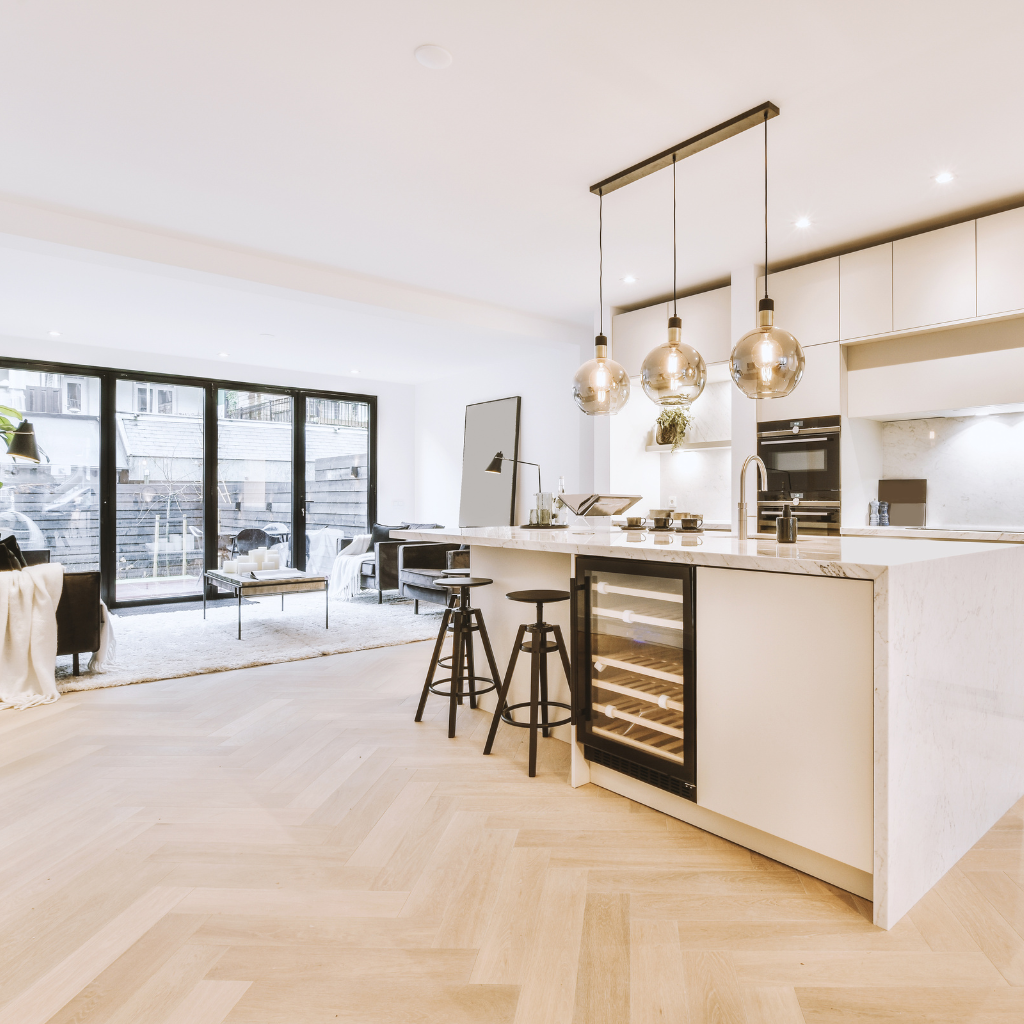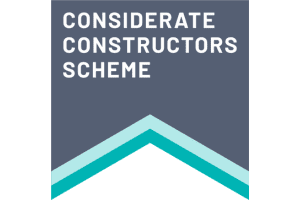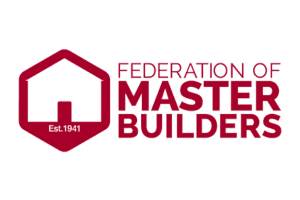Creative kitchen extension ideas empower homeowners to maximize their culinary spaces elegantly. Consider integrating an open-plan layout that blends cooking and dining areas, enhancing functionality and sociability. Installing skylights or large glass panels invites natural light and visually expands the space while incorporating multifunctional islands that can offer additional storage and Seating. For those exploring further transformative possibilities, integrating unique storage solutions or specialized lighting designs could reveal additional layers of sophistication and utility.
Key Takeaways
- Consider a single storey kitchen extension with glazed panels to bring in natural light and visually expand the existing space.
- Implement an open-plan design to merge kitchen and dining areas, enhancing sociability and creating a multi-functional space.
- Integrate a kitchen island for additional storage, seating, and workspace, making the most of the existing space while improving overall functionality.
- Use multi-functional fixtures and appliances to maximize efficiency, especially in small kitchens, ensuring the space remains practical and versatile.
- Install skylights or strategically placed windows to enhance natural light and space perception, further amplifying the sense of openness in your multi-functional space.
What Are the Key Building Regulations for a Kitchen Extension?
In crafting a kitchen extension, the elegance of design intertwines with the rigidity of building regulations.
Mastery of Building Regulations Approval guarantees the structure not only captivates but also conforms, safeguarding against costly rectifications.
Steering through these standards with precision avoids common pitfalls and elevates the functionality and aesthetic harmony of the return extension in extended space. For a detailed guide, refer to How to Build a Home Extension: Key Steps for House Expansion.
Understanding Building Regulations Approval
Before embarking on a side extension, homeowners must navigate the complexities of approval of building regulations, which ensures safety, functionality, and environmental efficiency. This crucial step shows the importance of complying with the guidelines to guarantee that your kitchen transformation is right.
The approval process includes sections dedicated to scrutinizing the structural elements, ensuring everything aligns with high standards for building integrity and occupant safety. Homeowners need planning permission before starting, which directly impacts the project timeline.
By following this guide and applying for permission early on, people ensure that every part of the modern kitchen extension meets requirements, from the foundation to the finish. This creates a great chance for a bespoke, sustainable space that aligns with aesthetic desires and functionality. A completed extension increases the home’s value and utility, allowing homeowners to enjoy a practical, beautiful kitchen that complies with all regulations.
Compliance with Extension Standards
Understanding the key building regulations for a kitchen extension is vital, as compliance guarantees the new space’s safety and functionality.
When planning a single storey extension, acquiring a lawful development certificate and securing planning permission are essential steps. These approvals confirm that the kitchen extension design meets local architectural standards and usage specifications.
Integrating these requirements can create a seamless blend of aesthetics and practicality in extension ideas. For instance, utilizing natural light through strategically placed windows can meet design aspirations and building code requirements for ventilation and energy efficiency.
Adhering to these guidelines for the ground floor extension enhances the extension’s utility and ensures it adds value to the property while maintaining legal compliance.
Common Regulations Mistakes to Avoid
Why do some kitchen extensions fail to meet expectations? Often, it’s due to overlooked building regulations that are essential for guaranteeing safety and functionality.
When planning your kitchen extension, integrating fire safety measures and a breakfast bar is a legal requirement and a vital component for sustainable living environments. The extension type often dictates specific fire safety protocols, such as the placement of smoke alarms and fire-resistant materials.
Moreover, underestimating the kitchen extension cost can lead to compromises in both design and compliance. Detailed planning should encompass all regulatory expenses to avoid financial oversights.
Savvy homeowners guarantee their kitchen extension projects adhere strictly to local building codes, which cover everything from structural integrity to energy efficiency, thereby maximizing both the aesthetic and practical benefits of their new space.
How Can I Maximize Kitchen Space with an Extension?
Maximizing kitchen space through an extension offers an exciting opportunity to reimagine the heart of the home with innovative layout plans. Whether opting for a single-story rear extension or a side return extension, this expansion can completely transform your kitchen’s functionality. This is an ideal way to increase space and value for terraced properties and detached homes while maintaining harmony with the surrounding environment.
When considering the design, kitchen units can be tailored to suit the new floor level and width, offering a sleek, modern touch. Pitched roofs and slim sightlines help create a spacious, open-plan space, while carefully choosing the color scheme ensures the aesthetic feels fresh and cohesive with the home’s original character. Most kitchen extensions benefit from planning consent, which should be checked with the local authority, especially if you’re in a conservation area or working with a listed building.
A kitchen diner layout elevates the social dynamics of the home, providing ample space for dining and entertaining. Whether incorporating a full width or expanding into a large open space, plan with the help of an architect to ensure the design suits your needs. Start planning your extension with the wow factor in mind, whether by adding extra cabinets, creating a large kitchen, or embracing different levels within the design to add dimension and flow.
This kind of extension perfectly creates a large kitchen that opens up seamlessly to your garden or living area, offering an inviting, functional, and stylish space.
Effective Kitchen Layout Plans
By meticulously crafting an effective kitchen layout plan, particularly focusing on an open-plan kitchen extension, the merging of the kitchen and dining space not only enhances fluidity but also amplifies the functionality of the new space. This type of extension offers a perfect opportunity to achieve a design that caters to the evolving needs of modern homes.
A well-thought-out floor plan should delineate areas, seamlessly integrating cooking, dining, and socializing zones. Strategic placement of appliances, such as in the center stage of the kitchen, can help optimize movement and usability. Additionally, using natural materials and clever storage solutions will further elevate the space’s aesthetic appeal.
Incorporating furniture that fits the space will ensure a harmonious look. At the same time, unique design elements like a roof lantern or glazed roof can help maximize light and create a bright, airy environment. Adding artwork and custom finishes helps personalize the space while maintaining a cohesive feel with the existing rooms.
This approach offers a solution to incorporate modern living within traditional settings for homes like an Edwardian house or semi-detached properties. Consider including features such as new sections that fit seamlessly into your current layout, ensuring plenty of functional storage and counter space. Whether expanding with a single-story extension or exploring permitted development options, these changes will be both important and beneficial for your home’s long-term comfort and appeal.
This design approach allows for creating a well-integrated and stylish kitchen extension that maximizes the use of existing rooms while maintaining an inviting, spacious atmosphere.
Incorporating a Kitchen Island into Your Design
While extending a kitchen, incorporating an island in kitchen extensions boosts functionality and serves as a stylish focal point. Adding an island unit in a new kitchen extension offers a dual solution: it enhances the aesthetic appeal and optimizes the workspace. This central feature is a wise investment, delivering long-term value by improving form and function. The design can be inspired by minimalist principles, creating a clean, streamlined look that complements the rest of the space.
Unlike traditional layouts, where storage can be confined to corners, an island opens up opportunities for more usable space. It can even replace bulky furniture or workstations, simplifying the design and maximizing the kitchen extension ideas to create a more cohesive layout. Whether used for meal prep, casual dining, or socializing, the island becomes a versatile and essential component of your new kitchen.
As you spend time planning, consider the island’s size, style, and material to match your overall vision, and make sure it’s positioned for easy access from all sides. By integrating an island, your kitchen is transformed into a space that is as practical as beautiful.
| Feature | Benefit | Consideration |
| Extra Storage | Maximizes space | Design alignment |
| Additional Seating | Enhances sociability | Size & placement |
| Work Surface | Expands prep area | Material choice |
In the design of a spacious kitchen, such an island becomes an indispensable component, encouraging a flowing, interactive environment. This structure should resonate with the kitchen design, reflecting the homeowner’s style while ensuring functional excellence.
Creating a Functional Kitchen Diner
Transforming a kitchen through an extension allows homeowners to seamlessly blend dining and cooking spaces, creating a multifunctional area ideal for everyday use and entertaining.
A spacious kitchen diner not only enhances the functionality but also elevates the aesthetic appeal of the home. To maximize the potential of a kitchen diner extension, consider these elements:
- Open Plan Layout: Design an open layout to open the space, ensuring a smooth flow between the kitchen and dining area.
- Integrated Dining Table: Incorporate a dining table that complements kitchen aesthetics, promoting cohesion and utility.
- Strategic Lighting: Layered lighting accentuates architectural features and creates an inviting atmosphere, essential for a modern, spacious kitchen diner.
What Are the Best Extension Ideas for Small Kitchens?
ExploringInnovation is key in exploring the domain of small kitchen extensions; sleek, multifunctional fixtures and hidden storage solutions can transform cramped cooking spaces into efficiency models. A well-planned extension kitchen design can unlock the potential of every square foot, providing the perfect opportunity to create a new room that serves multiple functions.
Selecting the right extension type involves a nuanced understanding of space dynamics, where even a few feet can greatly enhance the kitchen’s functionality without compromising style. For instance, a single-wall layout might be ideal for creating an open, airy space. At the same time, strategically placed windows and doors can enhance accessibility and the connection between the back garden and the kitchen.
Incorporating elements that maximize natural light, such as skylights or strategically placed windows, enlarges the space visually and infuses it with a light-filled, vibrant, airy feel. Full-height glazing can provide unobstructed garden views, bringing the outside in. This approach creates different zones within the room, offering clear separation between cooking, dining, and socializing areas, hugely popular in modern kitchen design.
Consideration of ceiling heights and good ventilation is crucial to ensure an inviting and comfortable atmosphere. By blending practical and aesthetic features, you can take full advantage of permitted development rights, bypassing the need for more extensive planning applications. Whether it’s extending into other rooms or connecting with the dining room, this type of extension offers homeowners a variety of options to increase the flow and functionality of their house.
This holistic design approach, with a combination of well-positioned elements, will ensure that the extension meets your current needs and provides long-term value. With the right brick and color accents, your extension can seamlessly integrate into the existing structure while still making a bold design statement. Most extensions today aim for a harmonious mix of form and function, so don’t expect to settle for anything less than a transformation.

Innovative Small Kitchen Extension Ideas
Maximizing space on the ground floor with ingenuity, small kitchens can be beautifully extended to enhance functionality and style.
The glazed kitchen extension stands out among the most effective small kitchen extension ideas. It introduces abundant natural light and a visual expansion of space without requiring extensive structural changes, making it a great choice for a single storey rear extension.
The side return kitchen extension is another ingenious way to utilize neglected narrow areas alongside the kitchen, transforming them into vibrant dining spaces or utility areas, and integrating seamlessly with the internal spaces of your home.
Glazed Kitchen Extension: This creates an illusion of a larger space with natural lighting, ideal for a single storey extension.
Side Return Kitchen Extension: Efficiently uses narrow outdoor spaces to expand your kitchen and enhance the flow of internal spaces.
Kitchen Diner Extension Ideas: Integrates dining areas seamlessly into the kitchen, fostering a multifunctional space that maximizes the use of internal spaces.
These options expand your kitchen and enhance its aesthetic appeal and practicality, transforming both your internal spaces and outdoor areas.
Choosing the Right Type of Extension
Small kitchens benefit immensely from thoughtful extensions that not only maximize space but also enhance functionality and aesthetic appeal. A popular choice is the single-story rear extension, which seamlessly expands the kitchen into the backyard, offering a new domain of culinary possibilities.
For those who cherish a blend of indoor and outdoor ambiance, consulting with interior designers about glazed kitchen extension ideas is worth considering. These kitchens introduce natural light while connecting the kitchen and living area, creating a fluid, open space.
When planning to add an extension, it’s essential to adapt the design to blend with existing structures, ensuring a harmonious integration that enhances utility and beauty. For more on transforming your home, check out how to find the perfect garage conversion idea for your space.
Designing for Maximum Natural Light
While considering kitchen extensions for small spaces, prioritizing natural light can profoundly impact both the functionality and atmosphere of the area. Harnessing the illuminative power of the sun not only enhances the aesthetic appeal but also promotes a healthier, more welcoming environment.
Here are some innovative ways to maximize natural light:
- Roof lights: Installing skylights or roof windows above can flood a compact kitchen with daylight, making the space feel larger and airier.
- Glazed doors: Incorporating full-height glazed doors, especially facing south, allows uninterrupted sunlight throughout the day while providing a seamless passage to outdoor spaces.
- Glass extension: A glass extension with transparent walls offers a modern solution that brings maximum light and visually expands the area.
How to Plan a Modern Open-Plan Kitchen Extension?
Planning a modern open-plan kitchen extension enhances a home’s aesthetic appeal and merges functionality with style.
By integrating the living space with the kitchen, homeowners can foster a more sociable environment where activities flow seamlessly from cooking to lounging.
Additionally, incorporating elements that connect the indoors with the outdoors can create a fluid progression, elevating the overall spatial experience.
Benefits of an Open Plan Design
Adopting open-plan design extension ideas for a kitchen extension not only enhances the aesthetic appeal but also transforms the functionality of the living space.
This layout seamlessly integrates various home zones, promoting a more fluid shift between the kitchen and living areas and often extending to dining, indoor, and outdoor spaces.
The benefits of such a design include:
- Enhanced Social Interaction: Reduces barriers between spaces, fostering communication and social gatherings.
- Increased Natural Light: Open spaces allow for an unobstructed flow of light, making the areas appear larger and more welcoming.
- Flexible Layout Options: The ability to customize the living space according to changing needs or preferences and adapt effortlessly to different activities and functions.

Integrating Living Space and Kitchen
To effectively integrate living spaces and kitchens in a modern open-plan extension, careful consideration of design elements is paramount. The best way to approach this project is by choosing various features that improve the functionality and overall aesthetic of the space. For example, installing sliding doors can visually expand the room, creating a seamless connection between the kitchen and living areas. These doors allow light to flood the space and give a sense of openness and flexibility.
In the design stage, think about the contrast between materials. A wood finish for the flooring or cabinetry can provide warmth and texture, complementing the more sleek finishes typically found in modern extensions. The existing house should be taken into account, ensuring the new design enhances the original house without overwhelming it.
When planning the roof, a flat roof can be a great solution, particularly with skylights, which help improve light flow. This feature is especially valuable in areas like a south-facing terrace or garden, which can be maximized for sunlight. Adding concealed storage options can improve the aesthetic, keeping the space tidy and functional while maintaining a clean, uncluttered look.
Regarding layout, ensuring a smooth connection between living spaces and the kitchen should be a priority. An open-plan setup can allow for more meters of usable space, making the most of every inch available. The hob, for instance, can be centrally placed in the kitchen to allow the cook to interact with others in the living space, enhancing the area’s social dynamics.
As with any extension of this scale, it’s important to monitor the progress at each stage of construction carefully. The undertaking of such a project may seem expensive, but with the right planning, the final result will be an open-plan extension that blends modern functionality with the charm of the old buildings.
By combining the charm of the original house with new design elements, the result will be a space that both tends to your needs and enhances the overall living experience.
| Feature | Benefit |
| Open-plan layout | Enhances spatial perception and social interaction |
| Sliding doors | Blurs boundaries, extends visual space |
| Flat roof | Allows for natural lighting, modern look |
| Integrated zones | Simplifies movement, enriches usability |
| Material Palette | Unifies the decor, complements modern aesthetics |
This layout optimizes kitchen utility and transforms it into a vibrant hub of the home.
Creating a Seamless Indoor-Outdoor Transition
Building on the idea of an integrated living and kitchen space, a modern open-plan kitchen extension can further enhance the connection between indoor comforts and the beauty of outdoor living.
Emphasizing the seamless shift to the garden space, strategic design choices play a pivotal role. Here are key elements to evaluate:
- French Doors: Incorporate French doors to offer a classic, elegant entryway to the garden, enhancing both light and visual flow.
- Bi-Fold Doors: Opt for bi-fold doors to create a wide, unobstructed opening that merges the kitchen with the outdoor space, ideal for social gatherings and airy summers.
- Rear Kitchen Extension Ideas: Design the extension to complement and interact with the existing garden layout, using materials and styles that blur the boundaries between inside and out.
What Are the Cost Considerations for a Kitchen Extension?
Understanding the financial landscape of a kitchen extension begins with methodically breaking down the costs associated with additional space. The first step is to decide on the project’s scope and ensure that the budget aligns with the vision. This initial stage is crucial to maximize your investment and achieve success.
Budgeting for design and materials demands a keen eye for detail and an appreciation for innovation, ensuring that aesthetics align seamlessly with functionality. For example, timber for beams or cabinetry can balance warmth and durability, while materials like oak or industrial finishes can add texture and character to the space. Whether you opt for a modern conservatory feel or a more rustic look, your material choices will significantly impact the extension’s costs and overall effect.
As you begin to construct, it’s important to consider the range of options available, from pendants to lighting, to enhance functionality and design. The team you choose for the project, including your builder or contractor, will be crucial in helping bring your vision to life. A registered professional can offer inspiration and ensure the work meets the necessary standards while keeping the project within budget.
Exploring cost-effective solutions, such as selecting boxes or modular storage systems for organizations, can significantly lower costs while maintaining a high practicality and style. Submitting the plans for planning approval well in advance can also prevent delays that might increase costs. This is essential in navigating any middle ground between budget constraints and the level of detail you wish to achieve.
The ideas for kitchen extension should also focus on optimizing circulation and openness, ensuring that the space feels expansive without overwhelming the existing layout. Carefully planning the eaves and volume of the extension can also affect how much light is brought into the room, which can be pivotal in maximizing the use of natural resources.
Ultimately, balance is key in deciding between limited options and your extension’s vast potential. With careful planning, your extension can become the center of the home, filled with character and offering a perfect blend of form and function. Depending on your preferences, the project can be characterized by thoughtful details that enhance the everyday living experience.
Breaking Down the Kitchen Extension Cost
Several factors influence the financial outlay required for a kitchen extension, each interplaying to shape the final cost. The dream of expanding your kitchen into a more usable space, incorporating innovative kitchen extension ideas, and creating new space necessitates a detailed financial strategy.
Here are the primary elements:
- Size and Complexity: Larger extensions and complex designs greatly increase costs.
- Location: Regional differences impact labor and material costs.
- Regulatory Requirements: Permits and local building codes can affect the overall expense.
These aspects must be meticulously assessed to guarantee that the transformation of your kitchen into a visually appealing and highly functional area aligns with your budget, maximizing the potential of the extra space without unwelcome financial surprises.
Budgeting for Design and Materials
Having outlined the primary cost elements of a kitchen extension, attention must now turn to the specifics of budgeting for design and materials.
Integrating the new design with the existing property requires a nuanced approach, especially optimizing the additional floor space. Strategic use of materials such as steel beams guarantees structural integrity and influences the overall budget.
These elements are pivotal in creating an open, seamless extension while providing options for additional storage solutions.
Budgeting for design and materials should not only reflect the aesthetic ambition but also accommodate the practical enhancements of the space.
This meticulous planning will ultimately dictate the functional and visual synergy between the old and the new structures.
Finding Cost-Effective Extension Solutions
While seeking cost-effective solutions for a kitchen extension, homeowners must thoroughly evaluate the inherent financial implications.
Strategically planning for a small kitchen extension can yield considerable enhancements with careful budget management. The aim is to create more space without a hefty price tag, focusing on innovative yet affordable design choices.
- Utility Room Integration: Incorporating a utility room within the extension plan maximizes functional space and potentially reduces costs by merging multiple needs into one area.
- Roof Windows: Installing roof windows instead of full-sized ones can enhance aesthetics and energy efficiency, thereby cutting long-term costs.
- Material Selection: Opting for cost-effective materials that still meet aesthetic and durability standards can considerably control expenses, making some of the best kitchen extension ideas achievable within a tighter budget.
How Can I Incorporate Glass Panels in My Kitchen Extension?
Integrating glass panels into a kitchen extension not only enhances the space’s aesthetic appeal but also maximizes the infusion of light and offers expansive views.
Thoughtful design can transform these transparent elements into striking architectural features, seamlessly blending indoor and outdoor environments.
The strategic placement and choice of glass can elevate the functionality and visual impact of the kitchen, making it a luminous focal point of the home.
Benefits of a Glazed Kitchen Extension
A glazed kitchen extension, with its expansive glass panels, not only enhances the aesthetic appeal of a home but also invites an abundance of natural light to the rear garden, creating an illusion of increased space.
This architectural choice transforms kitchen areas into bright, airy spaces, encouraging comfort and functionality. Here are the key benefits:
- Maximum Light Penetration: Large glass panels and skylights maximize daylight, reducing the need for artificial lighting.
- Seamless Outdoor Connection: Integrates the kitchen with outdoor living areas, offering views and easy access to gardens or patios.
- Visual Expansion: Glass creates a continuous visual flow, making the kitchen appear larger and more inviting.
Incorporating glass in a kitchen extension promises a luminous and visually expansive home environment.
Designing with Glass Panels for Aesthetic Appeal
Homeowners can further enhance their aesthetic appeal by creatively incorporating glass panels into their design, building on the natural advantages of glazed kitchen extensions. Using glass panels can transform a space into a sleek new kitchen extension that looks modern, spacious, and elegant. Strategically placed glass panels can partition spaces without closing them off, maintaining an open feel essential in creating a spacious kitchen.
| Design Feature | Benefit |
| Floor-to-ceiling Panels | Enhances spatial perception |
| Frosted Glass Designs | Provides privacy while maintaining a modern look |
| Structured Glass Blocks | Adds texture and depth to the best kitchen extension |
Enhancing Natural Light and Views
How can the strategic use of glass panels elevate the infusion of natural light and scenic views in a kitchen extension?
Incorporating glass panels in a rear extension, specifically in a single-story kitchen extension or a rear wall kitchen extension, magnifies the spatial perception and enhances connectivity with the outside space.
By designing a double-height space with floor-to-ceiling glass, the extension not only draws in more sunlight but also frames the landscape artfully, creating an illusion of an expansive environment.
- Floor-to-Ceiling Windows: Maximize light and view.
- Skylights: Introduce additional brightness from above.
- Glass Doors: Merge indoor and outdoor spaces.
These elements, when combined with clean lines, contribute to a kitchen that feels both open and luxuriously modern.
Conclusion
To summarize, extending a kitchen enhances functionality and transforms it into a visually engaging space. By adhering to building regulations and carefully defining the goals of the extension, homeowners can ensure they protect both their investment and the property’s structural integrity. Creativity utilizing every inch of space and embracing the best kitchen extension ideas, like glass panels, typically results in a modern, open-plan area ideal for culinary creations and social interactions.
When planning, it’s important to consider the floorplan that maximizes space and flow, ensuring all areas work in harmony. A clear scheme can define the visual direction, making it easier to enjoy the process and ultimately the result.
Homeowners should remember to appoint the right professionals for the job, as this ensures quality services and a smooth construction process. Money management is crucial, so understanding how to balance design, materials, and labor costs is essential.
With thoughtful planning, budget considerations, and a well-executed extension, the kitchen becomes a functional space and a reason to enjoy time spent cooking and socializing. Whether you’re creating a small section for dining or a full-width open-plan kitchen, the right approach will make it a space to enjoy for years to come.















